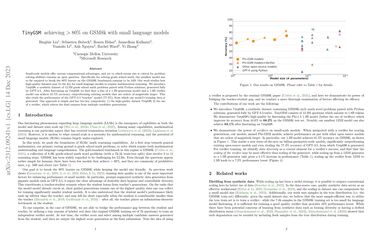TinyGSM: achieving >80% on GSM8k with small language models
Small-scale models offer various computational advantages, and yet to which extent size is critical for problem-solving abilities remains an open question. Specifically for solving grade school math, the smallest model size so far required to break the 80\% barrier on the GSM8K benchmark remains to be 34B. Our work studies how high-quality datasets may be the key for small language models to acquire mathematical reasoning. We introduce \texttt{TinyGSM}, a synthetic dataset of 12.3M grade school math problems paired with Python solutions, generated fully by GPT-3.5. After finetuning on \texttt{TinyGSM}, we find that a duo of a 1.3B generation model and a 1.3B verifier model can achieve 81.5\% accuracy, outperforming existing models that are orders of magnitude larger. This also rivals the performance of the GPT-3.5 ``teacher'' model (77.4\%), from which our model's training data is generated. Our approach is simple and has two key components: 1) the high-quality dataset \texttt{TinyGSM}, 2) the use of a verifier, which selects the final outputs from multiple candidate generations.
PDF Abstract| Task | Dataset | Model | Metric Name | Metric Value | Global Rank | Benchmark |
|---|---|---|---|---|---|---|
| Arithmetic Reasoning | GSM8K | Phi-GSM+V 1.3B+1.3B (verify48@1) | Accuracy | 81.5 | # 59 | |
| Parameters (Billion) | 2.6 | # 7 | ||||
| Arithmetic Reasoning | GSM8K | Phi-GSM 2.7B (fine-tuned) | Accuracy | 74.3 | # 81 | |
| Parameters (Billion) | 2.7 | # 8 |



 GSM8K
GSM8K
 MATH
MATH
 SVAMP
SVAMP
